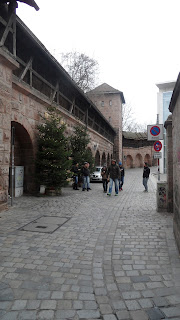Here's some more wall photos.
If you think it doesn't look medieval enough, please read on; there's a reason why.
My first stop was the so-called Nuremberg Castle.
The original dates from the 12th century, when Nuremberg was one of the most significant capitals in the Holy Roman Empire. Not THE capital, as there was no capital as such. Emperors set up camp somewhere for a while and then moved on. But Nuremberg was more important than most, and it was in 1356 that Emperor Karl IV enacted a Constitutional law that enshrined Nuremberg as a place where important stuff to the Empire had to be done. This law was called the Golden Bull. I'm not sure why, but I have to say if I could enact laws, that's certainly the title I would use.
By the way, my title today is in honour of Emperor Karl. There were also Konrads and Kristophes but I don't know so much about them. When the Holy Roman Empire was dissolved in the early 19th century Nuremberg was incorporated into what later became Germany, and lost much of its significance. You can do a tour of the castle, which I did, although I wasn't overly taken with it. It's full of spears, suits of armour and that sort of violent stuff. You sure do get a good view but.
Of course, castles are always built on the highest ground, and here's a view of part of the old town from one of the windows. That's another tor on the right. At first I couldn't understand why the castle seemed to be in such good condition, it being nearly 1000 years old 'n all. Well, surprise surprise, it's all on account of WWII. In January 1945, the RAF and the US Army Air Force deliberately targeted the old town, destroying much of the castle with it, and killing an estimated 6,000 Nurembergers. Much of it has been rebuilt since then. While they've tried to recreate the original style, it'll need a fair bit of weathering before it looks as old as it should. You've got to give the Europeans credit for stoically rebuilding following destruction wrought by war. Of course they've had plenty of practice over the years. I still think Ypres in Belgium, almost entirely rebuilt after WWI is the best example I've seen.
The old town is in fact a mixture of the old and not so old.
Lots of people live there, some in newish apartments and some in buildings made to look like they're older than they actually are.
This street (that starts with a w and has about 16 letters in its name) is actually listed in some tourist guides, but I wouldn't be going too far out of my way to see it. But I don't want to give the impression that the old town is not worth seeing; far from it. There are landmarks wherever you turn that are really quite charming. This one's called Weisser Turm.
It literally means White Tower, and apparently refers to the white mortar that is used to secure the bricks. You'll just have to trust me on that one. The other thing is that, bizarrely, there is a subway station right under it. They've cut away some bricks to make an entrance to the stairs down to the station. Seems a bit disrespectful to me, but I guess that's progress for you.
The other feature of the old town, and certainly the most popular at this time of year, is the Hauptmarkt, which at Christmas is known as the Christkindlmarkt. I visited the other night, but saw it in the daytime today.
It was nearly as crowded today as it was on Friday night, and the locals were drinking gluhwein in the same gargantuan quantities, despite the time of day. Maybe they're concerned that we're about to hit peak gluhwein, and this might be their last chance to drown in the stuff? Still, I did brave the teeming multitudes and shuffle down a couple of the aisles, finding that there are delicacies other than gluhwein and fruitcake to be had. Boiled lollies anyone?
I don't think there's any unsavoury association with boiled lollies in Germany, and no doubt a good thing too. In fact, the whole atmosphere was wholesome and family friendly. I happened to be there on the hour, when there is a little ceremony that is depicted with the figures that you might be able to see just below the clock in the tower of the church.
Oh well, maybe not. Again you'll just have to take my word for it. It was kind of like a cuckoo clock on a massive scale. But the whole population of the market, patrons and stallholders, stopped reverentially to pay homage to whatever it was that was happening. Maybe it was a re-enactment of Emperor Karl IV signing off on the Golden Bull?
All in all, a most convivial day out. A bit of a history lesson, a pleasant stroll and a sample of some local culture thrown in for good measure. I feel I've seen what I set out to in Nuremberg, and if you're ever in this part of the world, I'd thoroughly recommend it!

























